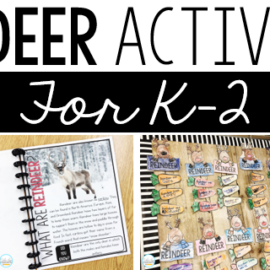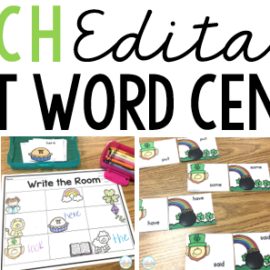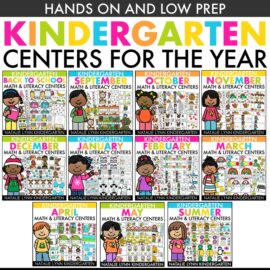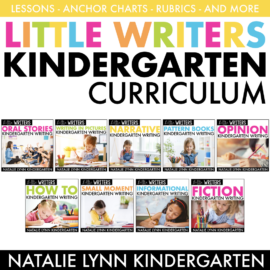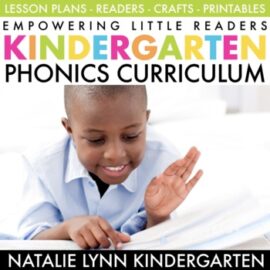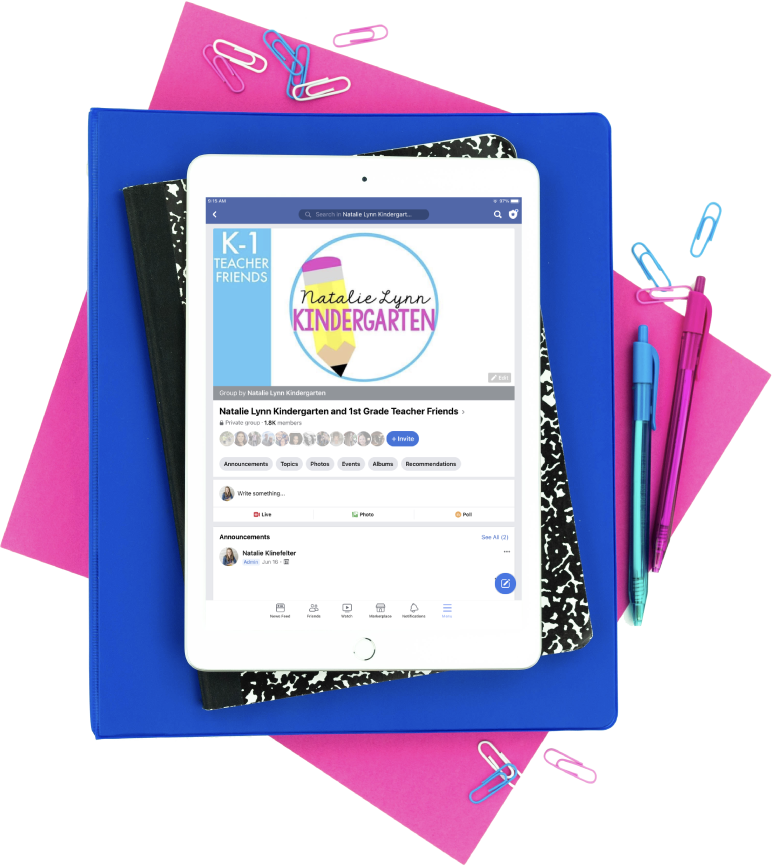
In this blog post: Discover how to plan your perfect math block in Kindergarten or first grade and grab some free math resources for math talks and math warm up activities!
We officially kicked off our Plan Your Perfect Year event in our free teacher Facebook group tonight and it was an AMAZING time! This week we are focusing on planning your perfect math block.
If you couldn’t join us for the live virtual PD, no worries! I am recapping it below and letting you on all the free downloads.
Guided Math – Yay or Nay?
The first question we asked was – guided math; is it a yay or a nay for you? Really, this question was meant to get you thinking about how you want to structure your math block.
Just because I structured my math block one way, doesn’t mean it’s the perfect fit for you!
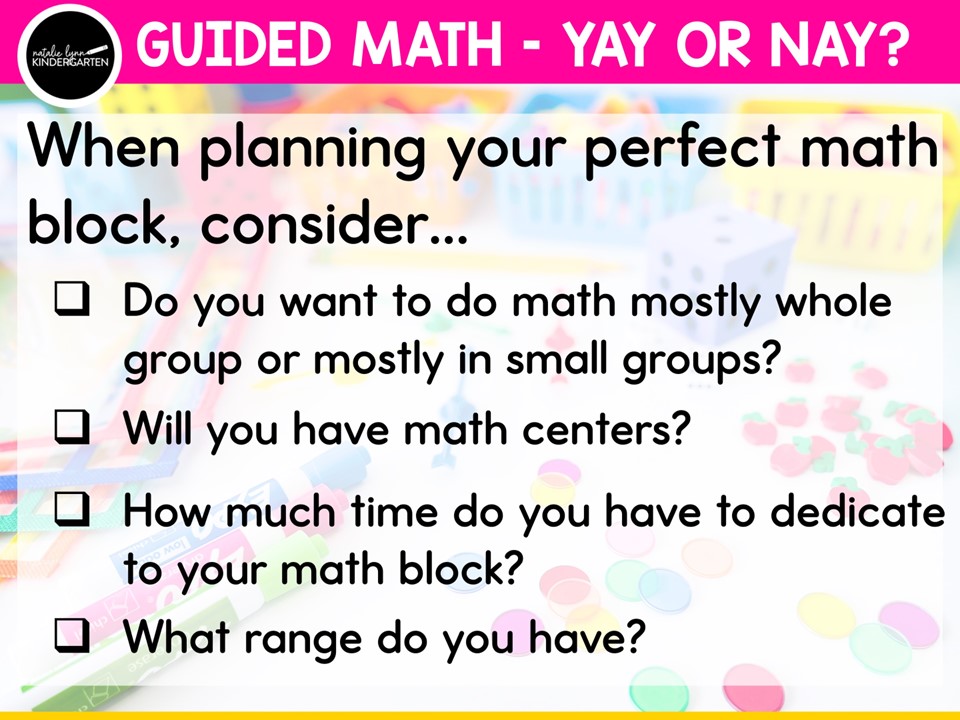
Some of the questions to consider when planning your perfect math block are:
- Do you want to do math mostly whole group or mostly in small groups?
- Will you have math centers?
- Can your students be independent in centers relatively quickly, or do you need to spend more time upfront teaching procedures?
- How much time do you have to dedicate to your math block?
- What range of skills and abilities do you have?
All of these questions will help you decide if a traditional guided math model is a good fit for you and your classroom.
Of course, if it isn’t, that’s okay!
I’m going to show you how you can plan your perfect math block no matter how you answered those questions.
Planning Your Perfect Math Block
When planning your perfect math block in Kindergarten or first grade, you can break it down into 5 main sections to make planning a little easier:
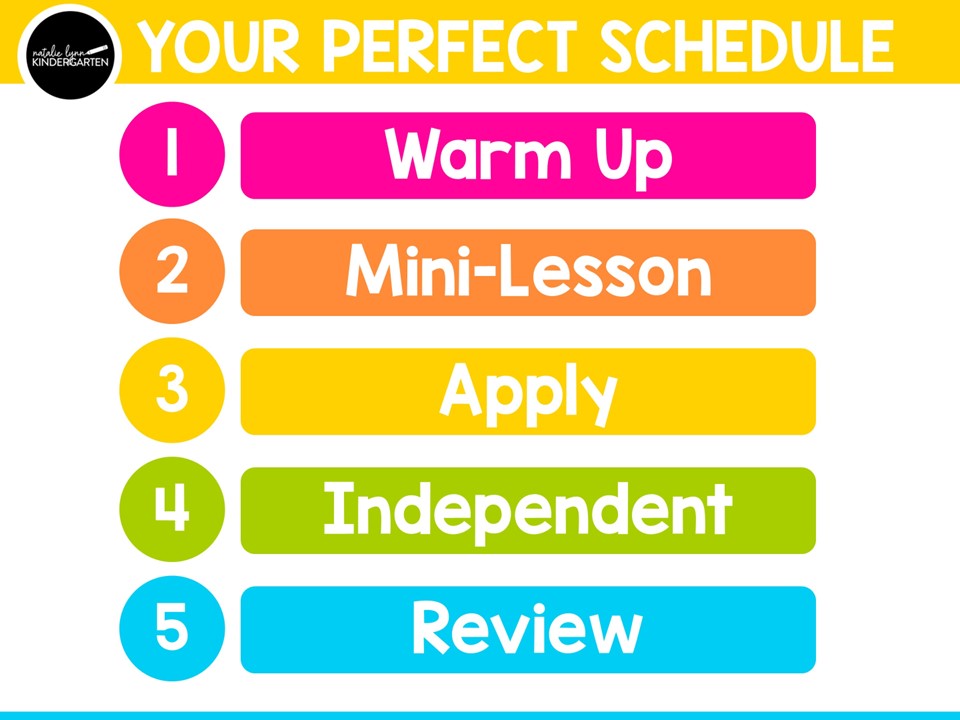
- Math warm up
- Math mini-lesson
- Apply (partner or teacher-led practice)
- Independent practice
- Review
Let’s take a closer look at what each of these sections of your math block might look like.
Let’s Plan: Math Warm Ups
I have to admit, my least favorite part of working out is the warm ups. I just want to get right into the meat of the workout! But I know that if I don’t warm up, i’m going to regret it later.
The same goes for our math block!
Math warm ups serve a few different purposes:
- Focusing students’ attention on the lesson
- Reviewing past skills
- Building number sense
- Using movement to smooth our transition
Depending on the time of day you have your math block, it can be a little bit of a rough transition. Students might be tired and a little squirrely.
Starting your math block with a math warm up combines movement, novelty, and academics to help focus students’ attention and get them ready to learn.
Your math warm up time should only take about 2-3 minutes, and it can be as simple as an interactive movement-based counting activity.
In the free download below, I have a set of Movement-Based Math Warm Ups ready to go for you!

Just cut these out and place them on a binder ring. It’s easy to flip to a math warm up activity and go.
Ideas for differentiation:
- As the year goes on, change the number you count to from 10 to 20 or even beyond.
- Count forward and backward.
- Skip count! Instead of counting by ones, count by tens, fives, or twos.
Let’s Plan: Math Mini-Lesson
Now that your students are focused from the math warm up activity, you are ready for your teacher-led math mini lesson.
Your teacher-led math mini lesson should be between 5-15 minutes. This can be short and direct, or a little longer and include hands-on practice by students.
This part of your lesson is the “I do” and the “We do” part of your lesson.
It can include:
- Introducing the teaching point
- Modeling for students
- Giving a few students a chance to try
Your math mini lesson can also include a time for all students to practice with your support at the carpet.
For example, in this lesson on teen numbers, we sat around the carpet and all practiced building numbers together. Students had my support as well as the support from seeing students around them completing the same task.
Now that your math mini lesson is complete, you need to decide: Will you complete the rest of the math block whole group or in small groups?
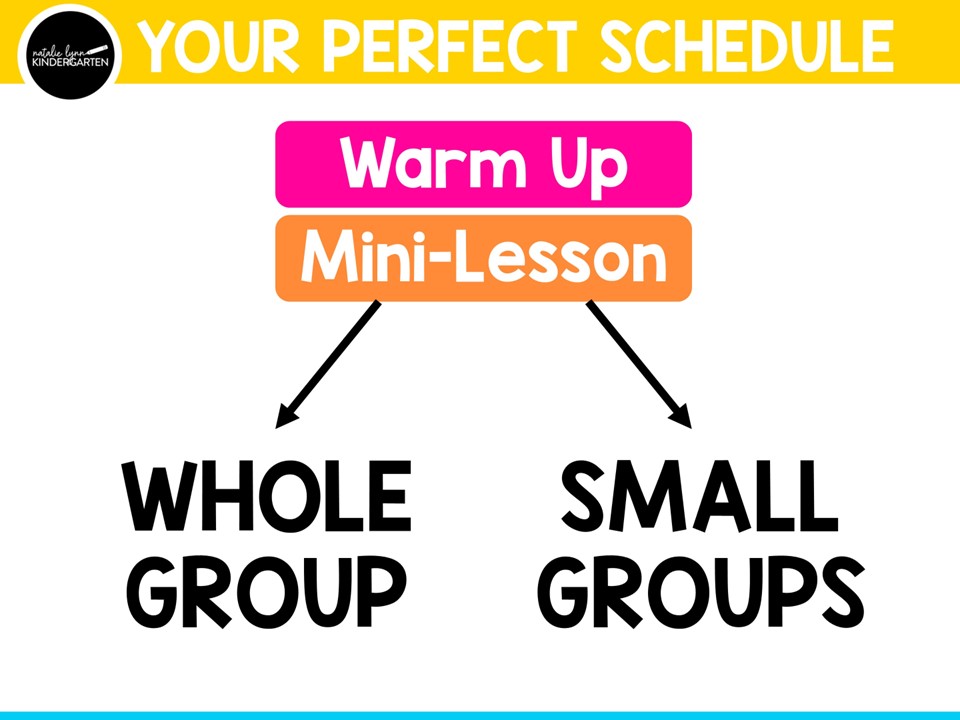
There is no right answer here! It’s completely up to you and what you are most comfortable with.
If you go with whole group, you will do the Apply and Independent part of the lesson as a class.
Students can then review in math centers later on if that is a part of your day, and that is also when you can meet with intervention and enrichment math groups.
If you go with small groups, students will now transition into math centers. You will pull small groups to complete the Apply partner practice activities. Students can complete the independent practice after.
Let’s Plan: Apply
Whether completed whole group or in small groups, the Apply part of your math block is the “you go with support” piece of the gradual release model.
It might be about 5-15 minutes, and it often includes partner games or practice activities.

Some easy partner practice activities include:
If you are pulling small groups, this is where you will differentiate your instruction to either scaffold, practice, or enrich the targeted standard.
Just like your reading small groups, each group might receive different instruction based on their specific needs!
Let’s Plan: Independent Practice
The independent practice is the “you do” part of your math block. This will probably only take 3-5 minutes, although it could take longer.
The independent practice activity is usually a math worksheet. I know, I know! But some things just need to be worksheets.
This is your chance to informally assess students’ learning to guide your instruction.
Side note: Take note of how much support you are giving students as they complete this independent practice activity. Are they completing it 100% on their own, or are you needing to offer support and guidance?
Let’s Plan: Review
Just like literacy, it’s important that we have times to spiral practice and review math skills throughout out day!
The three review activities I will be discussing are:
- Math centers
- Math talks
- Quick looks
Math Centers
Again, how you run your math centers is completely personal to you and what works for your classroom.
Personally, I did not have much time available for math centers, so I kept mine completely free flowing and gave students free choice. When they completed one activity, they could simply go choose another!
For all activities, students could complete them on their own or with a partner.
You can see it in the picture below, but the math centers they could choose from included:
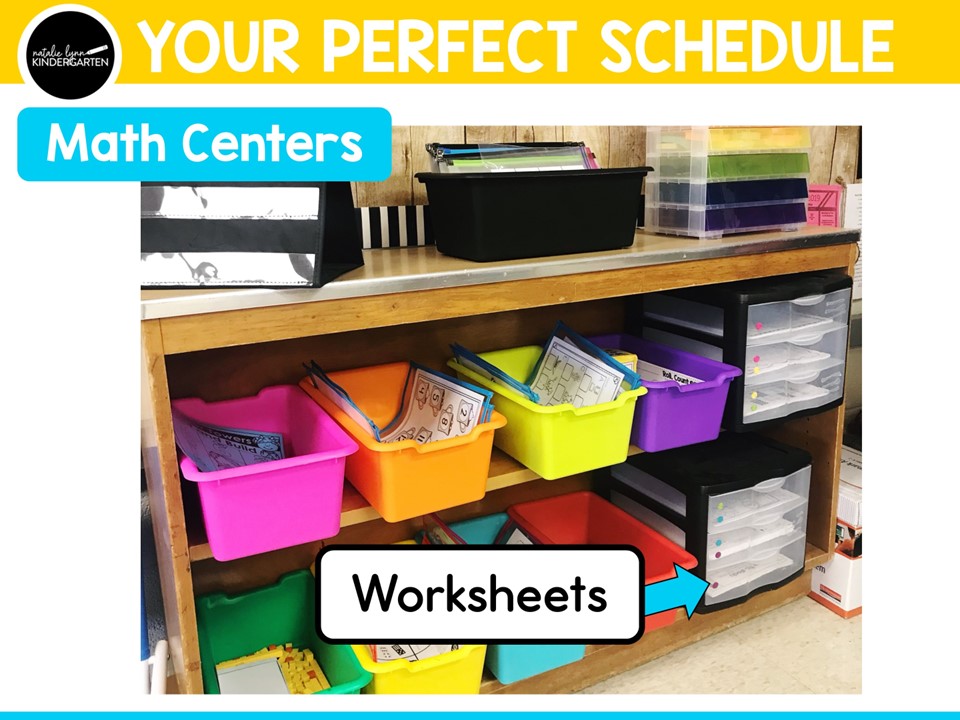
Math Baskets: These are the colorful bins in the picture. They usually included partner games, pocket dice centers, or any activity that needed spinners or manipulatives.
Grab and Go: These were small pouches located in that black bin on top of the bookshelf. They included puzzles, matching activities, and clip cards. Basically, anything that they could grab and go!
Worksheets: I don’t know about you, but my students went CRAZY for math worksheets. I have no idea why, but this was always my most popular option!
The math worksheets are in those plastic drawers. You can see colorful dot stickers on the drawers. To differentiate the worksheets, students could choose an activity from their color drawers.
Sensory bin: I kept my sensory bins in plastic sweater tubs. It made it easy to swap it out for math and literacy!
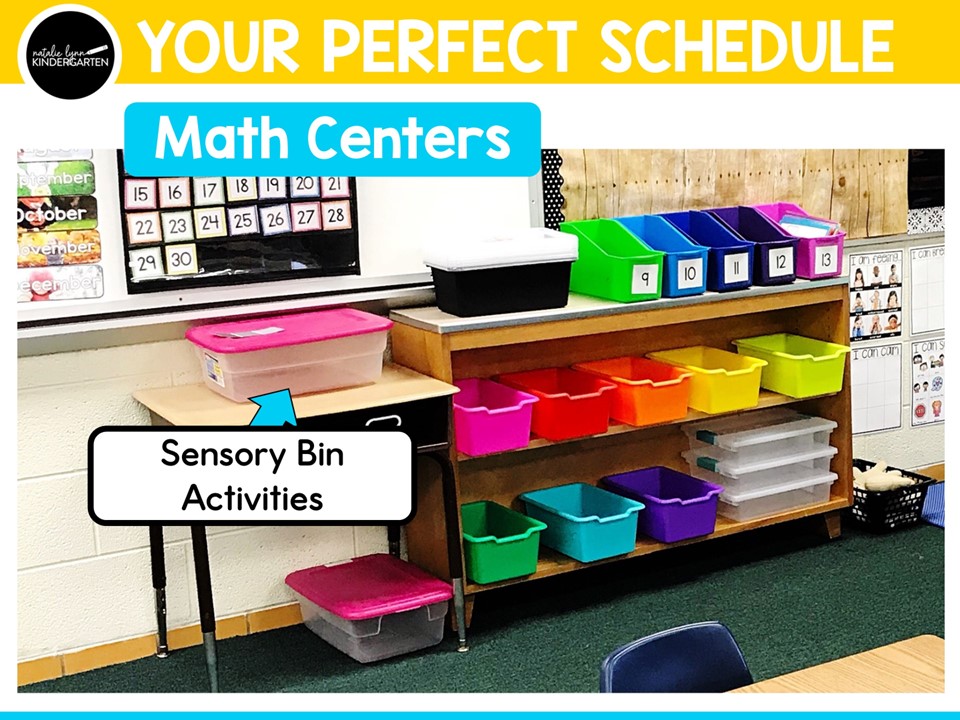
Find sensory bin activities for kindergarten here.
Math Around the Room: Math write the room is an easy math center because it doesn’t really take up any space. Students just need a clipboard and recording sheet, and then they search the room for the cards!
Find math around the room activities for the year for Kindergarten here and for first grade here.
Math Talks
Math talks are another great way to review math skills and build number sense. These can be just a few minutes each week, but they get students talking math and numbers!
You don’t need any fancy materials to start math talks, although you can find them out there.
An example of a math talk would be showing students 5 dots.
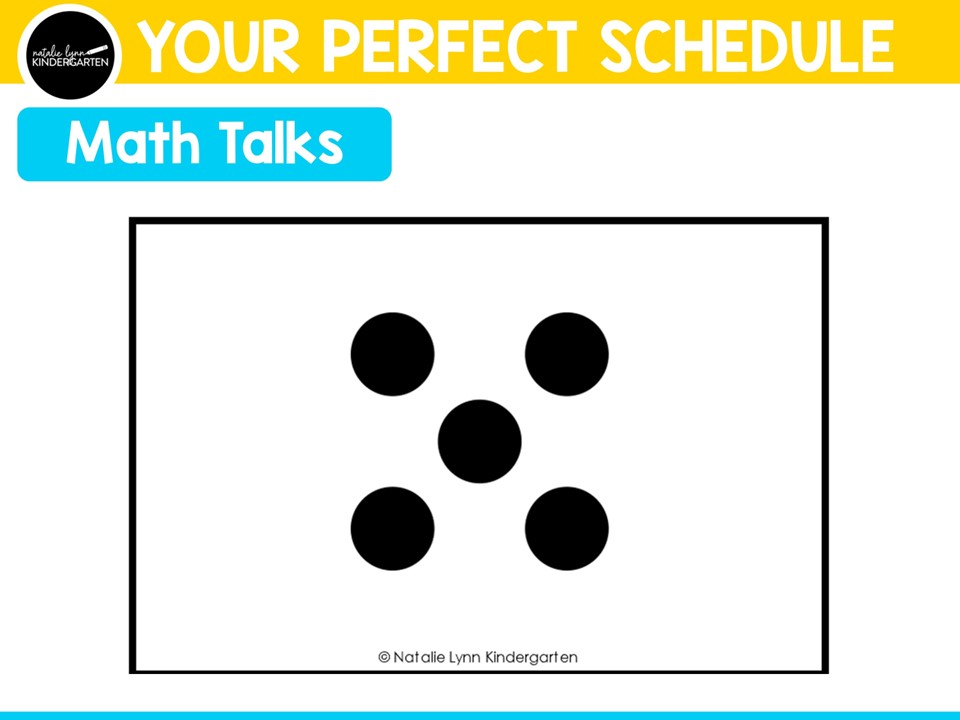
Give students time to think about the image. Having think time is important!
You can ask students:
- What do you notice?
- How many dots did you see in all?
- How do you know?
- When you looked at these dots, did you see any smaller sets of dots making up five?
Math Quick Looks
Another great way to build number sense and math fluency is through quick look cards.
This is an easy routine that you can use whenever you have a few extra minutes of filler time, or you can add it in to your math warm up or morning meeting.
Simply flash students a card! They will say the number shown as quickly as they can.
As students practice more and more, the faster they will get.

You can download a free set of math quick look cards at the end of this blog post.
Want a digital option? I also have brand new Number Race Fluency Slides that your students will love!
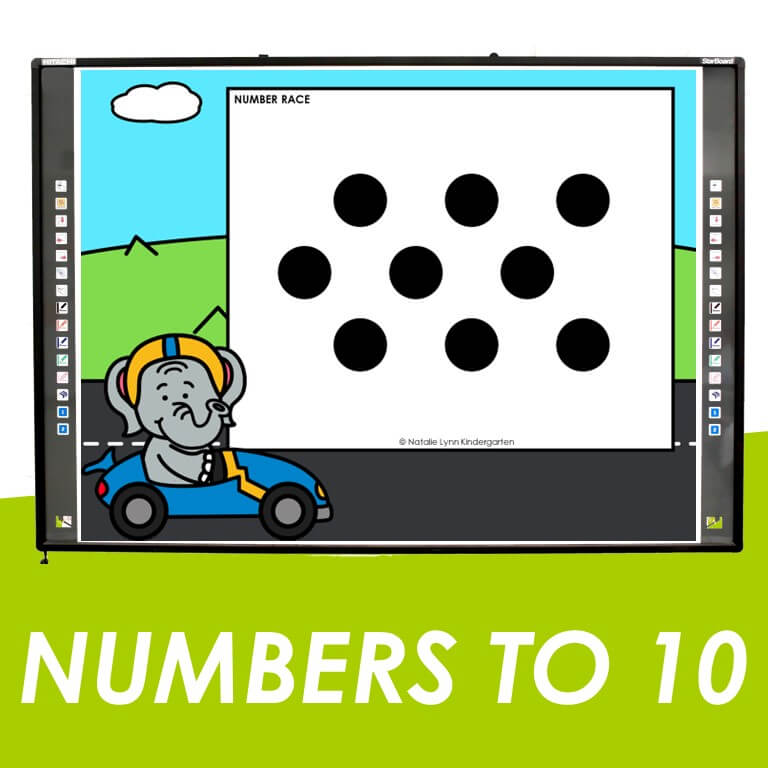
For these, just mix up the slides. You can delete slides as needed.
Students will say the number shown on each slide as quickly as they can. But when they see a Pit Stop slide, the fun begins! Students will complete the action shown until you switch the slides.

This is a great way to add in movement to your day!
Grab the Number Race Fluency Slides here.
Math Curriculum
Are you looking for a math curriculum that takes the guesswork out of planning for you? My Pre-k – First Grade math curriculums are all on Flash Sale today in honor of our virtual PD! They are back at their buy in pricing through tomorrow.
Math Free Downloads
Thank you so much for stopping by this week to plan your perfect math block with me! You can grab your free math resources below, including the Math Warm Ups and the Quick Look Cards:

Do you love free stuff?
Math Warm Ups + Subitizing Cards
Grab this set of movement-based math warm up activities and subitizing quick look cards perfect for preschool, pre-k, kindergarten, and first grade!
I hope you’ll join me next week to plan your perfect literacy block!
Natalie


